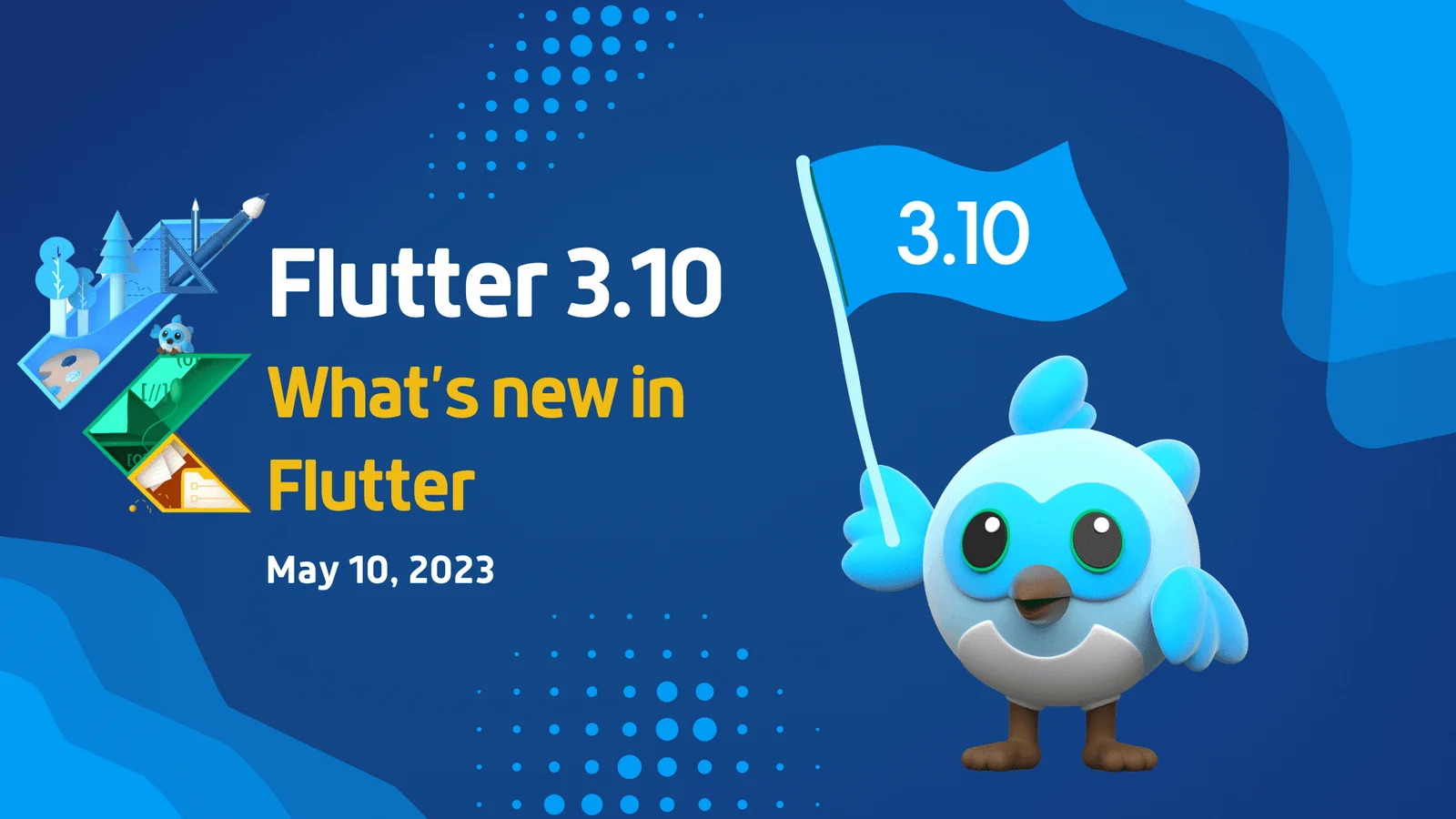As Flutter is getting more popular day by day, with every release, it provides new features. Google built the open-source Flutter mobile app development framework. A new Flutter is being released on May 10, 2023.
This new release brings a host of new features and improvements that are designed to make mobile app development faster, easier, and more flexible than ever before.
Overall, Flutter 3.10 is a major release that brings a number of new features and improvements to the Flutter SDK. If you’re a Flutter developer, be sure to check out this release and see what it has to offer.
Here is a list of new features in Flutter’s latest release:
1.) New Material 3 Widgets:
- Material 3 is a new design language that brings a fresh look and feels to Flutter apps. It includes a new typography system, new shapes and shadows, and new animations.
- The new typography system in Material 3 is designed to be more expressive and modern. It uses a wider range of weights and sizes, and it includes new features like variable fonts.
- The new shapes and shadows in Material 3 are designed to be more dynamic and engaging. They use a variety of new techniques, such as gradients and blurs, to create a more visually appealing experience.
- The new animations in Material 3 are designed to be more fluid and natural. They use a variety of new techniques, such as easing curves and spring physics, to create a more realistic feel.
2.) Improved Performance:
Flutter 3.10 includes a number of performance improvements, including:
a.) Improved Rendering Performance:
Rendering performance has improved with this version in a number of ways, including:
- Optimizing the rendering pipeline: Flutter 3.10 has also been optimized to improve the rendering pipeline, which can also lead to performance improvements.
- Using the GPU for more rendering tasks: Flutter 3.10 now uses the GPU for more rendering tasks, which can significantly improve performance.
- Using more efficient rendering algorithms: Flutter 3.10 uses more efficient rendering algorithms, which can also improve performance.
These improvements can lead to noticeable performance improvements in Flutter apps, especially on devices with powerful GPUs. For example, Flutter 3.10 can render complex animations up to 60% faster than previous versions of Flutter. This can make Flutter apps feel more responsive and fluid, which can improve the user experience.
b.) Improved Memory Usage:
This version improves memory usage in a number of ways, including:
- Using less memory for widgets: Flutter 3.10 uses less memory for widgets, which can lead to significant memory savings.
- Optimizing the memory usage of the rendering engine: Flutter 3.10 has also been optimized to improve the memory usage of the rendering engine, which can also lead to memory savings.
- Using more efficient memory management algorithms: Flutter 3.10 uses more efficient memory management algorithms, which can also lead to memory savings.
These improvements can lead to noticeable memory savings in Flutter apps, which can improve the performance and battery life of devices. For example, Flutter 3.10 can use up to 20% less memory than previous versions of Flutter. This can make Flutter apps run more smoothly and efficiently, which can improve the user experience.
c.) Improved Startup Time:
This version improves startup time in a number of ways, including:
- Preloading resources: Flutter 3.10 now preloads resources, such as images and fonts, which can significantly improve startup time.
- Optimizing the startup code: Flutter 3.10 has also been optimized to improve the startup code, which can also lead to startup time improvements.
- Using more efficient startup algorithms: Flutter 3.10 uses more efficient startup algorithms, which can also improve startup time.
These improvements can lead to noticeable startup time improvements in Flutter apps. For example, Flutter 3.10 can start up to 50% faster than previous versions of Flutter. This can make Flutter apps feel more responsive and fluid, which can improve the user experience.
3.) New Developer Tools:
Flutter 3.10 includes a number of new developer tools, including:
a.) A New Debugger:
Here are some specific examples of the new features and improvements in the Flutter 3.10 debugger:
- The new user interface is more intuitive and easier to use. The new user interface is designed to be more user-friendly and to make it easier to find and use the features that you need. For example, the new debugger has a toolbar that contains all of the most commonly used debugging tools.
- The ability to step through code line by line, and to inspect the values of variables. The new debugger allows you to step through code line by line so that you can see how the code is executing. You can also inspect the values of variables so that you can see what the values of the variables are at any given point in time.
- The ability to set breakpoints, and to pause execution at specific points in the code. The new debugger allows you to set breakpoints so that you can pause the execution of the code at specific points. This can be useful when you are trying to debug a specific part of the code.
- The ability to view the call stack, and to see the hierarchy of functions that are currently being executed. The new debugger allows you to view the call stack so that you can see the hierarchy of functions that are currently being executed. This can be useful when you are trying to debug a bug that is caused by a function call.
- The ability to inspect the state of the application, and to see the values of all of the app’s variables. The new debugger allows you to inspect the state of the application so that you can see the values of all of the app’s variables. This can be useful when you are trying to debug a bug that is caused by a variable that is not being initialized correctly.
- The ability to debug Flutter apps that are running on a device or in the emulator. The new debugger can be used to debug Flutter apps that are running on a device or in the emulator. This means that you can debug your apps on a real device, which can help you to find and fix bugs that are caused by hardware or software issues.
b.) A New Performance Profiler:
The new profiler provides a number of features that were not available in the previous profiler, including:
- A timeline view that shows the execution of your app’s code over time. This view can help you identify bottlenecks in your app’s performance.
- A memory profiler that shows how much memory your app is using. This view can help you identify memory leaks in your app.
- A CPU profiler that shows how much CPU time your app is using. This view can help you identify CPU-intensive operations in your app.
- A Raster stats tab that shows how long it takes to render each frame of your app. This tab can help you identify slow rendering operations in your app.
The new performance profiler is a valuable tool for developers who want to improve the performance of their Flutter apps. It can help you identify and fix performance problems that would be difficult to find without it.
c.) A New Layout Inspector:
The new inspector provides a number of features that were not available in the previous inspector, including:
- A widget tree view that shows the hierarchy of widgets in your app. This view can help you identify the widgets that are causing layout problems.
- A layout explorer that shows the layout of your app’s widgets. This view can help you identify the constraints that are affecting the layout of your app’s widgets.
- A properties inspector that shows the properties of each widget. This view can help you understand how the properties of each widget are affecting the layout of your app.
A new layout inspector is a valuable tool for developers who want to debug layout issues in their Flutter apps. It can help you identify and fix layout problems that would be difficult to find without it.
These tools make it easier to debug and optimize your Flutter apps.
d.) Support for New Platforms:
Flutter 3.10 adds support for new platforms, including:
- macOS Ventura
- iOS 16
- Android 13
This means that you can now build Flutter apps for even more devices.
Conclusion
Flutter 3.10 is a major release that brings a number of new features and improvements to the Flutter SDK. If you’re a Flutter developer, be sure to check out this release and see what it has to offer.
If you are having any issues or difficulty handling Flutter tasks, hire Flutter developers from us. We are also available to manage your problems via phone. Get a free consultation call with us and get your solution for any problems related to Flutter!





